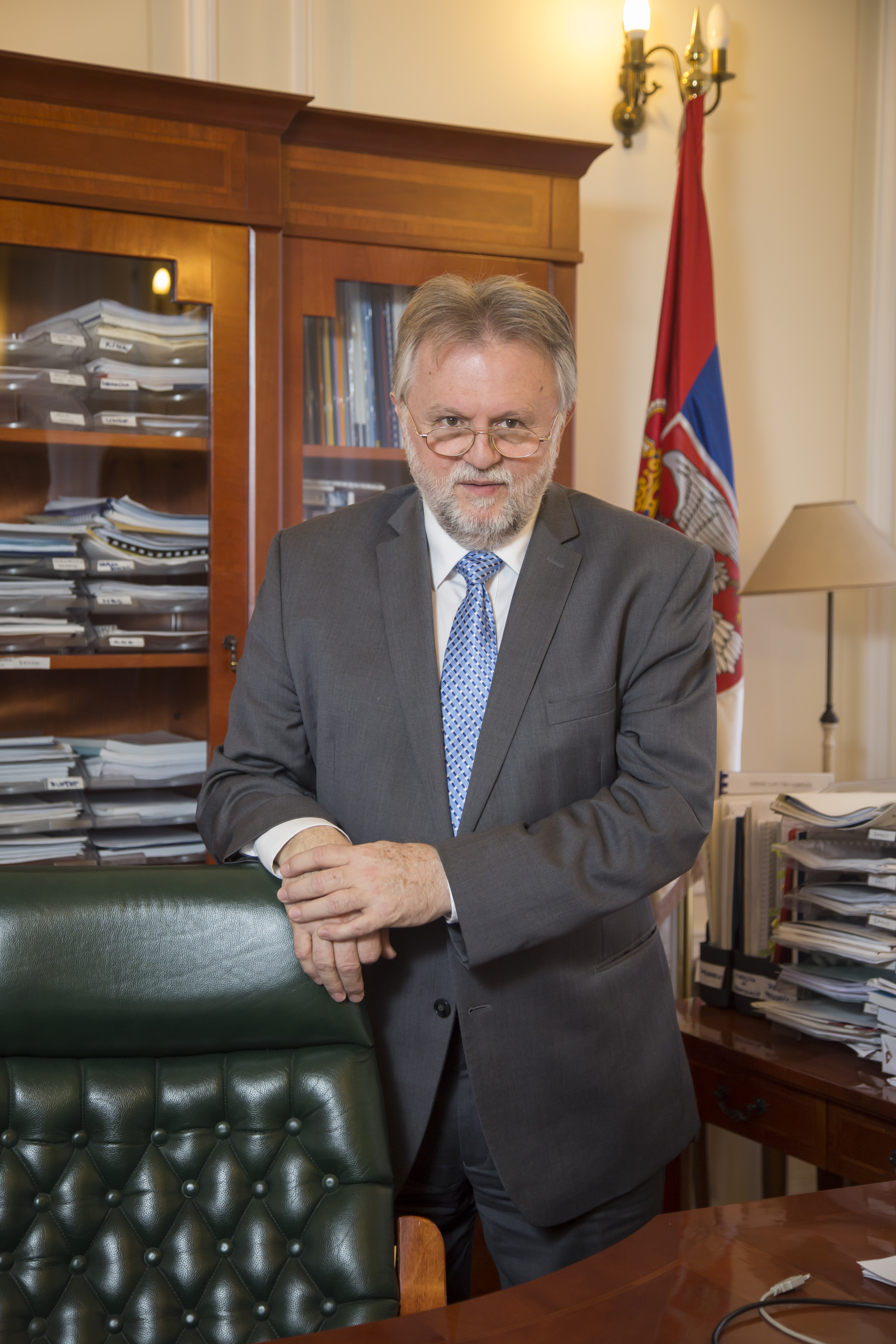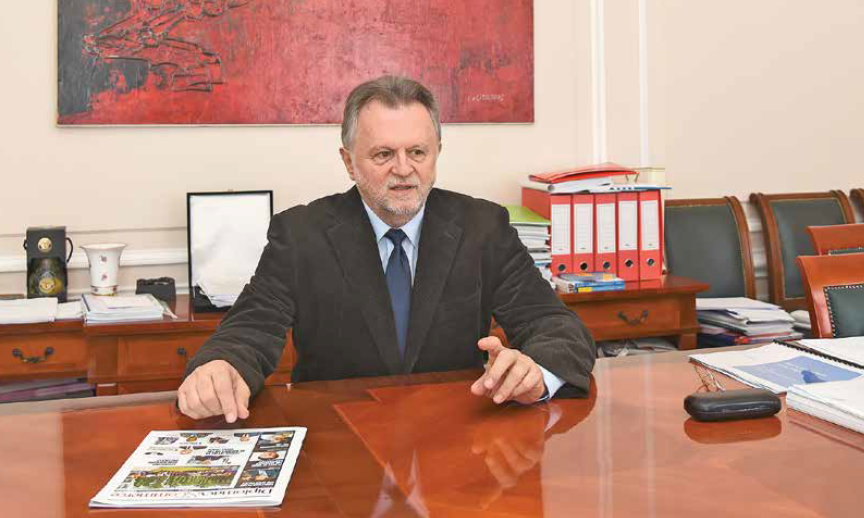I am very proud of the fiscal and the overall macroeconomic results achieved during the past three years of reforms, especially when viewed against the starting position
After some slowdown this year, Serbia has good chances to return to more robust growth path. It is critical to complete structural reforms in public administration, the financial sector and state owned companies to secure these favourable results in the long run.

What made you proud the most during your mandate so far?
-
I am very proud of the fiscal and the overall macroeconomic results achieved during the past three years of reforms, especially when viewed against the starting position. When I took office in mid-2014 the economy was in a freefall. Fiscal deficit was expected to reach staggering 8.8 percent of GDP, economic growth was negative (at -3.7 percent in the third quarter), current account deficit was in double digits, and the share of debt to GDP was increasing at the fastest rate in the recent history. Last IMF programme went off track in late 2011 and the international financial markets have lost confidence in Serbia: interest rate spreads exceeded 500 basis points and fiscal liquidity was declining at an alarming rate. Bloomberg calculated that we had 78 days to bankruptcy. By contrast, at the end of 2016 fiscal deficit was only 1.3 percent and we are now running a fiscal surplus of more than 1.5 percent of GDP for the first nine months of 2017. GDP growth reached 2.8 percent in 2016 and is now estimated at 2.3 percent for this year. Debt to GDP peaked at 74 percent last year and is now down to less than 64 percent. Interest rate spreads have been reduced four times to 130 basis points. These are impressive achievements that substantially and consistently exceeded expectations of IFIs, economic analysts, and rating agencies. I am equally proud of the two less visible aspects of the programme. Firstly, the political window of opportunity for the long needed fiscal consolidation and reforms that was created by then Prime Minister Vučić based on the election results of March 2014. Secondly, our ability to design and implement a balanced program that combined macroeconomic fiscal and monetary stability, financial (banking) sector reforms, and structural reforms in the real economy for medium-term sustainable growth, with politically and socially acceptable costs.

What role IMF had in these achievements?
— Absolutely critical. IMF support was essential not only in forging commitment to a specific set of detailed macro-stability and structural objectives, but also in specifying and observing (structur-al) benchmarks, and constraints (especially expenditure ceilings). Over more than three years we have developed a very good professional and personal collaboration which helped us update the programme in line with the actual results (performance), and properly reflect political and social preferences while fully observing the rules and commitments. Sometimes these rules imposed additional strain on the already complex three-year three-prong precautionary programme, but we moved quickly up the learning curve to better reflect country specific circumstances and true ownership of reforms. A greater empirically based flexibility in the IMF peer-review system would have been helpful in fine-tuning the program in the second and third year. This programme also assumed substantive collaboration between the IMF and the World Bank on structural reforms supported by a range of Bank advisory services
and lending instruments.
Are the abovementioned results sustainable?
-
I am reasonably confident but must admit that sustainability issues often loom large in most transition economies. Serbia is no exception given its late start of reforms, and (both perceived and real) weak ownership of reforms. It is therefore critical to complete structural reforms in public administration, the financial sector and state owned (mostly utility) companies.
Is the slowdown of the economy something to be worried about or not?
-
As mentioned, growth rate for this year has been revised down to 2.3 percent from the original 3.0 percent forecast. We agreed with the IMF team that this slowdown is due to a fall in electricity output, slower construction sector and severe drought conditions in agriculture, with no other signs of recession or structural growth problems. Furthermore, all adverse factors are of cyclical nature and will likely be compensated with higher sectoral growth rates in 2018. Assuming no new shocks, this will result in stronger GDP growth of 3.5-4.0 percent next year. In the longer run, Serbian economy will be well positioned to achieve structural growth rates of above 4 percent provided the present investment effort in infrastructure yields the expected boost in competitiveness and continuous productivity increases are secured through programmes to enhance human capital through innovation and better education.
What are the structural obstacles which are hampering robust growth and the FDI flows? Is the government ready to address them?
— In recent years foreign direct investment consistently exceeded the value of the current account deficit. The level and efficiency of both public and private investment needs to increase further to enable higher sustained GDP dynamics and convergence in incomes and standards of living with the EU and regional comparator countries. More money for investment will not be enough if we do not continue to remove barriers to economic growth. We are already pursuing multiple initiatives to complete institutional reforms in the critical areas of public and private sector governance, strengthen the rule of law (especially related to protection of ownership and creditor rights, and in contract enforcement), resolve
NPLs and advance financial sector reforms that would enable improved access to finance. We are also improving public sector capacity to plan and efficiently implement investment projects aligned with strategic development objectives and focused on crowding-in private investment. Our efforts to improve all dimensions of investment climate will continue, often going beyond the “doing business” indicators where we made significant improvements since the start of reforms. Our objective is to have a transparent and predictable tax system (including para-fiscal charges) based on compliance implemented by a thoroughly modernized tax administration.
Some experts point out that the progress related to restructuring of Serbia’s state-owned enterprises was too slow. What remains to be done?
-
We made significant progress in resolving problem SOEs placed in the portfolio of the Privatization Agency. A handful of large companies (mostly in metals, basic chemicals, and pharmaceuticals) are now approaching final stages of privatisation or restructuring. Most of them will likely find strategic buyers and restore competitiveness in the domestic and export markets through management and production restructuring. If needed, we have adequate budget resources to cover severance payments and retraining programmes.
-
Does the idea of a Western Balkans Common Market make sense to you? Would it be good for Serbia and the region?
-
Countries of the Western Balkans (essentially former Yugoslavia plus Albania) already trade a lot. Next to trade with the EU, Western Balkans are our largest trading partner. Deepening this to a common market concept makes a lot of economic sense. This will expand trade flows to free movement of capital and people, foster technological and managerial synergies and enhance the competitiveness of the region in external markets. At the same time it will lower or eliminate protection barriers and, thus, better prepare Western Balkan countries for the eventual EU accession. Political economy issues may stand in the way if not addressed properly. That’s why politicians must lead and spearhead this process, and representatives of strong interest groups that expect to lose from the common market must give their prior consent.
How do you see the pace of the accession process?
— I see EU accession process as a test of our ability to get key institutions and policies right. Although every country should do (most of) these improvements for their own benefit, EU membership as the final step in this process is important as a credible signal, and a tangible target. If we continue to open new chapters in line with our readiness, and the political signals from the EU and at home remain stable and supportive, all chapters can be closed in 4-5 years and the accession process can realistically be completed by 2022. This would be a straight engaging path to EU membership. In real life, burdened with politics and complex game-plans, it is not always obvious that honest and straight strategies prevail.
WE ARE THINKING TO RE-ENTER THE EUROBOND
Why Serbia has abandoned the eurobond markets lately? Are you planning comeback?
— Serbia has been absent from the Eurobond market for three-four years now. Initially, because Eurobonds were too expensive. Hence, we resorted to cheaper sources such as budget support loans from UAE. More recently we were absent because of reduced gross financing needs owed to good fiscal results. Last year our actual borrowing needs turned out to be almost 1.5 billion Euros lower than originally planned and we were able to raise sufficient financing in the domestic markets at lower rates. Similarly, this year we recorded a fiscal surplus of more than 600 million euros at the end of September instead of a planned 500 million euros deficit. This lowered our gross borrowing needs by more than a billion euros. Nevertheless, our interest rate spreads have come down sufficiently since the start of the program to now justify refinancing of some bonds issued five or more years ago. So it would now make sense to issue a sovereign bond to lower the interest cost, as well as improve the maturity and currency structure of our debt. Depending on the market circumstances, the decision to re-enter the Eurobond may be reached before the end of this year or in early 2018.